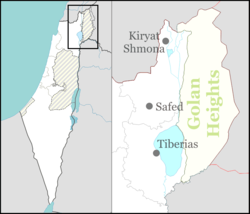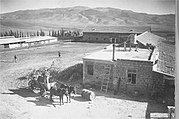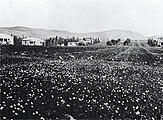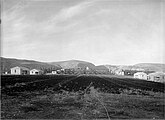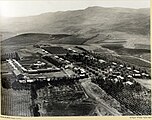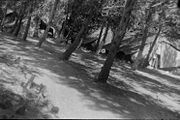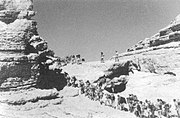Kfar Giladi
Kfar Giladi
כפר גלעדי | |
|---|---|
 Founders' house | |
| Coordinates: 33°14′33″N 35°34′30″E / 33.24250°N 35.57500°E | |
| Country | |
| District | Northern |
| Council | Upper Galilee |
| Affiliation | Kibbutz Movement |
| Founded | 1916 |
| Founded by | Hashomer members |
| Population (2022)[1] | 702 |
| Website | www |
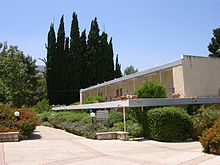
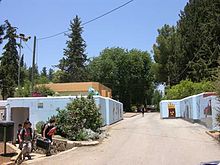

Kfar Giladi (Hebrew: כְּפַר גִּלְעָדִי, lit. Giladi Village, Arabic: كفار جلعادي) is a kibbutz in the Galilee Panhandle of northern Israel.[2] Located south of Metula on the Naftali Mountains above the Hula Valley and along the Lebanese border, it falls under the jurisdiction of Upper Galilee Regional Council. In 2022 it had a population of 702.[1]
Kfar Giladi is also notable for archaeological discoveries such as Neolithic and Chalcolithic findings[3][4] as well as the remains of a Jewish mausoleum dating from Roman times.[5]
History
[edit]Kibbutz Giladi was founded in 1916 by members of Hashomer on land owned by the Jewish Colonization Association. It was named after Israel Giladi, one of the founders of the Hashomer movement. The area was subject to intermittent border adjustments between the British and the French, and in 1919, the British relinquished the northern section of the Upper Galilee containing Tel Hai, Metula, Hamra, and Kfar Giladi to the French jurisdiction. After the Arab attack on Tel Hai in 1920, it was temporarily abandoned. Ten months later, the settlers returned. Several older buildings stand on the kibbutz that memorialize previous battles on the site, before and during the 1948 Arab–Israeli War.
In 1921 a top secret arms store was dug 10 metres into the hillside. Measuring 5 by 5 metres square and 2 metres high its entrance was concealed in a stable. It was never discovered by the Mandate authorities.[6]
Between 1916 and 1932, the population totaled 40–70. In 1932, the kibbutz absorbed 100 newcomers, mainly young immigrants. From 1922 to 1948, between 8,000–10,000 Jewish immigrants were smuggled into Palestine through Kibbutz Giladi, circumventing the Mandatory ban on Jewish immigration.[7] The immigrants came from Syria, Lebanon, Turkey, Iraq, Afghanistan and Eastern Europe.
In an operation known as Mivtzah HaElef, 1,300 Jewish children were smuggled out of Syria between 1945 and 1948. At the kibbutz, the children were dressed in work clothes and hidden in the kibbutz chicken coops and cowsheds.[7]
In August 2006, during the 2006 Lebanon War, twelve reserve IDF soldiers were killed after being hit by a Katyusha rocket launched by Hezbollah from Southern Lebanon. The group of artillery gunners were gathering on the kibbutz in preparation for action in the conflict.
Israel–Hamas war
[edit]During the war between Hamas and Israel, northern Israeli border communities, including Kfar Giladi, faced targeted attacks by Hezbollah and Palestinian factions based in Lebanon, and were evacuated.[8]
2024 Israeli invasion of Lebanon
[edit]On 30 September 2024, the Israeli Defense Forces (IDF) launched a limited ground invasion into Southern Lebanon. On that same day, the IDF declared that Kfar Giladi became a closed military area.[9]
-
Kfar Giladi 1930
-
Kfar Giladi 1930
-
Kfar Giladi 1934
-
Kfar Giladi 1937
-
Palmach camp at Kfar Giladi. 1948
-
Members of the Palmach from Kfar Giladi on exercise. c. 1947

Landmarks
[edit]Eight historic buildings built in 1922 are being preserved and restored. Built of Galilee stone and materials imported from Lebanon, they are among the few remaining vestiges of early kibbutz housing.[2]
Archaeology
[edit]Neolithic and Chalcolithic remains
[edit]An archaeological site at Kfar Giladi was excavated in 1957 and 1962.[3] It revealed remains four stages of occupation in different periods. An early neolithic stage was suggested to date between 6400 and 5800 BC. Finds included Dark faced burnished ware with incisions and rope patterns.[10] Flints included axes, adzes, arrowheads and denticulated sickle blade elements. Similar finds were located in a later neolithic stage including a female clay figurine dating between 5800 and 5400 BC. Two later periods of occupation were attributed to chalcolithic occupations similar to Wadi Rabah.[4]
Another nearby neolithic site was excavated in 1973.[11] They found Byblos points and tips of Jericho points and Amuq points, polished cutting axes, chisels and fine-toothed sickles. Finds were similar to Tell Ramad.[11]
Mausoleum Yad Hezekiah – Giv'at ha-Shoqet
[edit]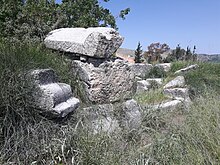
In 1961, J. Kaplan conducted an excavation at Giv'at ha-Shoqet, a hill located southwest of the built area of Kfar Giladi, and revealed a mausoleum with three burial levels. The uppermost level, Stratum I, contained an empty sarcophagus inscribed with the Hebrew name Hezekiah, indicating it belonged to a Jewish individual. Kaplan proposed that the mausoleum was built to house this sarcophagus.[5]
The layer below, Stratum II, situated beneath the mausoleum floor, contained seven rectangular graves, some featuring lead coffins adorned with depictions such as Hercules; one of them had a gold diadem and bracelet adorned with semi-precious stones. The lowest stratum (stratum III) included a marble sarcophagus belonging to Heracleides.[5]
Kaplan identified two usage periods: the first (Stratum I and III) dating to no later than the Severan dynasty (192–235 AD), with Hezekiah and Heracleides buried, and the second (Stratum II) with the seven graves dating around 290–310 AD.[5]
See also
[edit]- Keeping the Kibbutz (2010 documentary about Kfar Giladi)
- Kfar Giladi–Tel Hai Cemetery
References
[edit]- ^ a b "Regional Statistics". Israel Central Bureau of Statistics. Retrieved 21 March 2024.
- ^ a b Ashkenazi, Eli (February 24, 2012). "A fine and public place". Haaretz. Retrieved April 19, 2019.
- ^ a b Kaplan, J., Kfar Giladi, Israel Exploration Journal, 8:274, 1958
- ^ a b Moore, A.M.T. (1978). The Neolithic of the Levant. Oxford University, Unpublished Ph.D. Thesis. pp. 436–442.
- ^ a b c d "Volume 5/Part 1 Galilaea and Northern Regions: 5876-6924", Volume 5/Part 1 Galilaea and Northern Regions: 5876-6924, De Gruyter, pp. 19–22, 2023-03-20, doi:10.1515/9783110715774/html, ISBN 978-3-11-071577-4, retrieved 2024-01-22
- ^ Ben Zvi, Rahel Yanait (1976; translated by Marie Syrkin 1989) Before Golda: Manya Shochat. A Biography. Biblio Press, New York. ISBN 0-930395-07-7 p.114
- ^ a b Ashkenazi, Eli (February 24, 2012). "Kibbutz Celebrates Past as Pre-state Gateway to Holy Land". Haaretz. Retrieved April 19, 2019.
- ^ IDF to evacuate civilians from 28 communities along Lebanese border amid attacks
- ^ "Metula, Misgav Am, Kfar Giladi in Israel's North declared closed military zones". jpost.com. Retrieved 2024-09-30.
- ^ Council for British Research in the Levant, p. 54 & 63; British School of Archaeology in Jerusalem; British Institute at Amman for Archaeology and History (1973). Levant. British School of Archaeology in Jerusalem. Retrieved 1 May 2011.
{{cite book}}: CS1 maint: numeric names: authors list (link) - ^ a b Francis Hours (1994). Atlas des sites du proche orient (14000-5700 BP). Maison de l'Orient méditerranéen. ISBN 978-2-903264-53-6. Retrieved 1 May 2011.

